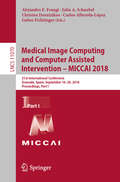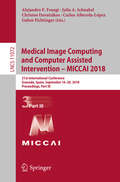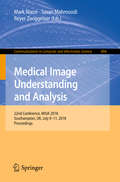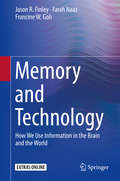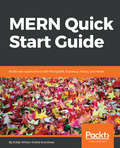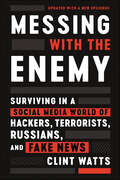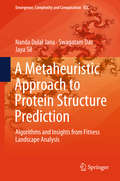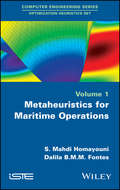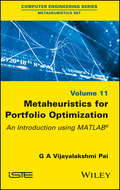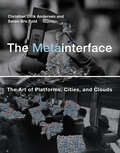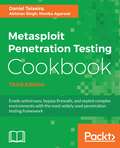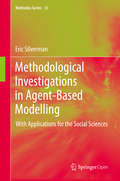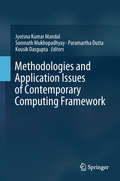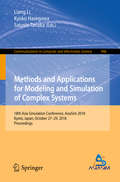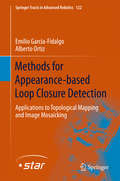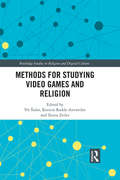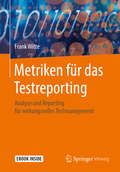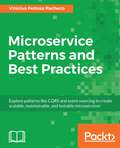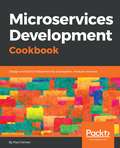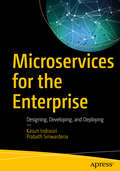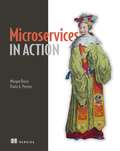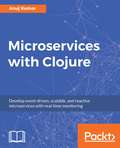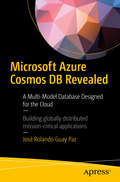- Table View
- List View
Medical Image Computing and Computer Assisted Intervention – MICCAI 2018: 21st International Conference, Granada, Spain, September 16-20, 2018, Proceedings, Part I (Lecture Notes in Computer Science #11070)
by Alejandro F. Frangi Gabor Fichtinger Julia A. Schnabel Christos Davatzikos Carlos Alberola-LópezThe four-volume set LNCS 11070, 11071, 11072, and 11073 constitutes the refereed proceedings of the 21st International Conference on Medical Image Computing and Computer-Assisted Intervention, MICCAI 2018, held in Granada, Spain, in September 2018. The 373 revised full papers presented were carefully reviewed and selected from 1068 submissions in a double-blind review process. The papers have been organized in the following topical sections: Part I: Image Quality and Artefacts; Image Reconstruction Methods; Machine Learning in Medical Imaging; Statistical Analysis for Medical Imaging; Image Registration Methods. Part II: Optical and Histology Applications: Optical Imaging Applications; Histology Applications; Microscopy Applications; Optical Coherence Tomography and Other Optical Imaging Applications. Cardiac, Chest and Abdominal Applications: Cardiac Imaging Applications: Colorectal, Kidney and Liver Imaging Applications; Lung Imaging Applications; Breast Imaging Applications; Other Abdominal Applications. Part III: Diffusion Tensor Imaging and Functional MRI: Diffusion Tensor Imaging; Diffusion Weighted Imaging; Functional MRI; Human Connectome. Neuroimaging and Brain Segmentation Methods: Neuroimaging; Brain Segmentation Methods.Part IV: Computer Assisted Intervention: Image Guided Interventions and Surgery; Surgical Planning, Simulation and Work Flow Analysis; Visualization and Augmented Reality. Image Segmentation Methods: General Image Segmentation Methods, Measures and Applications; Multi-Organ Segmentation; Abdominal Segmentation Methods; Cardiac Segmentation Methods; Chest, Lung and Spine Segmentation; Other Segmentation Applications.
Medical Image Computing and Computer Assisted Intervention – MICCAI 2018: 21st International Conference, Granada, Spain, September 16-20, 2018, Proceedings, Part III (Lecture Notes in Computer Science #11072)
by Alejandro F. Frangi Julia A. Schnabel Christos Davatzikos Carlos Alberola-López Gabor FichtingerThe four-volume set LNCS 11070, 11071, 11072, and 11073 constitutes the refereed proceedings of the 21st International Conference on Medical Image Computing and Computer-Assisted Intervention, MICCAI 2018, held in Granada, Spain, in September 2018. The 373 revised full papers presented were carefully reviewed and selected from 1068 submissions in a double-blind review process. The papers have been organized in the following topical sections: Part I: Image Quality and Artefacts; Image Reconstruction Methods; Machine Learning in Medical Imaging; Statistical Analysis for Medical Imaging; Image Registration Methods. Part II: Optical and Histology Applications: Optical Imaging Applications; Histology Applications; Microscopy Applications; Optical Coherence Tomography and Other Optical Imaging Applications. Cardiac, Chest and Abdominal Applications: Cardiac Imaging Applications: Colorectal, Kidney and Liver Imaging Applications; Lung Imaging Applications; Breast Imaging Applications; Other Abdominal Applications. Part III: Diffusion Tensor Imaging and Functional MRI: Diffusion Tensor Imaging; Diffusion Weighted Imaging; Functional MRI; Human Connectome. Neuroimaging and Brain Segmentation Methods: Neuroimaging; Brain Segmentation Methods.Part IV: Computer Assisted Intervention: Image Guided Interventions and Surgery; Surgical Planning, Simulation and Work Flow Analysis; Visualization and Augmented Reality. Image Segmentation Methods: General Image Segmentation Methods, Measures and Applications; Multi-Organ Segmentation; Abdominal Segmentation Methods; Cardiac Segmentation Methods; Chest, Lung and Spine Segmentation; Other Segmentation Applications.
Medical Image Understanding and Analysis: 22nd Conference, Miua 2018, Southampton, Uk, July 9-11, 2018, Revised Selected Papers (Communications In Computer And Information Science #894)
by Mark Nixon Sasan Mahmoodi Reyer ZwiggelaarThis book constitutes the refereed proceedings of the 22st Annual Conference on Medical Image Understanding and Analysis, MIUA 2018, held in Southampton, UK, in July 2018.The 34 revised full papers presented were carefully reviewed and selected from 49 submissions. The papers are organized in topical sections on liver analysis, medical image analysis, texture and image analysis, MRI: applications and techniques, segmentation in medical images, CT: learning and planning, ocular imaging analysis, applications of medical image analysis.
Meme di barzellette divertenti di Fortnite Battle Royale Epic
by Joke FactoryOttieni l’accesso istantaneo alle più divertenti barzellette di Fortnite! Stai per scoprire le più divertenti battute di Fortnite di sempre. Questo libro è ricco di alcune delle barzellette più divertenti di Fortnite. Scopri gli argomenti più popolari di Epic Games insieme a scherzi e meme sciocchi, ridicoli e semplicemente esilaranti su di loro! Scarica la tua copia istantaneamente! Acquista oggi e scopri tutte le barzellette più popolari per Fortnite!
Memory and Technology: How We Use Information in the Brain and the World
by Jason R. Finley Farah Naaz Francine W. GohHow is technology changing the way people remember? This book explores the interplay of memory stored in the brain (internal memory) and outside of the brain (external memory), providing a thorough interdisciplinary review of the current literature, including relevant theoretical frameworks from across a variety of disciplines in the sciences, arts, and humanities. It also presents the findings of a rich and novel empirical data set, based on a comprehensive survey on the shifting interplay of internal and external memory in the 21st century. Results reveal a growing symbiosis between the two forms of memory in our everyday lives.The book presents a new theoretical framework for understanding the interplay of internal and external memory, and their complementary strengths. It concludes with a guide to important dimensions, questions, and methods for future research.Memory and Technology will be of interest to researchers, professors, and students across the disciplines of psychology, philosophy, library and information science, human factors, media and cultural studies, anthropology and archaeology, photography, and cognitive rehabilitation, as well as anyone interested in how technology is affecting human memory._____ "This is a novel book, with interesting and valuable data on an important, meaningful topic, as well as a gathering of multidisciplinary and interdisciplinary ideas...The research is accurately represented and inclusive. As a teaching tool, I can envision graduate seminars in different disciplines drawing on the material as the basis for teaching and discussions." Dr. Linda A. Henkel, Fairfield University "This book documents the achievements of a vibrant scientific project – you feel the enthusiasm of the authors for their research. The organization of the manuscript introduces the reader into a comparatively new field the same way as pioneering authors have approached it." Prof. Dr. Wolfgang Schönpflug, Freie Universität Berlin
MERN Quick Start Guide: Build web applications with MongoDB, Express.js, React, and Node
by Eddy WilsonBuild web applications with MongoDB, ExpressJS, React, and NodeKey FeaturesBuild applications with the MERN stackWork with each component of the MERN stackBecome confident with MERN and ready for more!Book DescriptionThe MERN stack is a collection of great tools—MongoDB, Express.js, React, and Node—that provide a strong base for a developer to build easily maintainable web applications. With each of them a JavaScript or JavaScript-based technology, having a shared programming language means it takes less time to develop web applications. This book focuses on providing key tasks that can help you get started, learn, understand, and build full-stack web applications. It walks you through the process of installing all the requirements and project setup to build client-side React web applications, managing synchronous and asynchronous data flows with Redux, and building real-time web applications with Socket.IO, RESTful APIs, and other concepts. This book gives you practical and clear hands-on experience so you can begin building a full-stack MERN web application.Quick Start Guides are focused, shorter titles that provide a faster paced introduction to a technology. They are for people who don't need all the detail at this point in their learning curve. The presentation has been streamlined to concentrate on the things you really need to know.What you will learnGet started with the MERN stackInstall Node.js and configure MongoDBBuild RESTful APIs with Express.js and MongooseBuild real-time applications with Socket.IO Manage synchronous and asynchronous data flows with ReduxBuild web applications with React Who this book is forThe book is for JavaScript developers who want to get stated with the MERN Stack.
Messing with the Enemy: Surviving in a Social Media World of Hackers, Terrorists, Russians, and Fake News
by Clint WattsA former FBI Special Agent and leading cyber-security expert offers a devastating and essential look at the misinformation campaigns, fake news, and electronic espionage operations that have become the cutting edge of modern warfare—and how we can protect ourselves and our country against them.Clint Watts electrified the nation when he testified in front of the House Intelligence Committee regarding Russian interference in the 2016 election. In Messing with the Enemy, the cyber and homeland security expert introduces us to a frightening world in which terrorists and cyber criminals don’t hack your computer, they hack your mind. Watts reveals how these malefactors use your information and that of your friends and family to work for them through social media, which they use to map your social networks, scour your world affiliations, and master your fears and preferences.Thanks to the schemes engineered by social media manipulators using you and your information, business executives have coughed up millions in fraudulent wire transfers, seemingly good kids have joined the Islamic State, and staunch anti-communist Reagan Republicans have cheered the Russian government’s hacking of a Democratic presidential candidate’s e-mails. Watts knows how they do it because he’s mirrored their methods to understand their intentions, combat their actions, and coopt their efforts.Watts examines a particular social media platform—from Twitter to internet Forums to Facebook to LinkedIn—and a specific bad actor—from al Qaeda to the Islamic State to the Russian and Syrian governments—to illuminate exactly how social media tracking is used for nefarious purposes. He explains how he’s learned, through his successes and his failures, to engage with hackers, terrorists, and even the Russians—and how these interactions have generated methods of fighting back. Shocking, funny, and eye-opening, Messing with the Enemy is a deeply urgent guide for living safe and smart in a super-connected world.
A Metaheuristic Approach to Protein Structure Prediction: Algorithms And Insights From Fitness Landscape Analysis (Emergence, Complexity And Computation Ser. #31)
by Nanda Dulal Jana Swagatam Das Jaya SilThis book introduces characteristic features of the protein structure prediction (PSP) problem. It focuses on systematic selection and improvement of the most appropriate metaheuristic algorithm to solve the problem based on a fitness landscape analysis, rather than on the nature of the problem, which was the focus of methodologies in the past. Protein structure prediction is concerned with the question of how to determine the three-dimensional structure of a protein from its primary sequence. Recently a number of successful metaheuristic algorithms have been developed to determine the native structure, which plays an important role in medicine, drug design, and disease prediction. This interdisciplinary book consolidates the concepts most relevant to protein structure prediction (PSP) through global non-convex optimization. It is intended for graduate students from fields such as computer science, engineering, bioinformatics and as a reference for researchers and practitioners.
Metaheuristics for Maritime Operations
by S. Mahdi Homayouni Dalila B.M.M. FontesMetaheuristic Algorithms in Maritime Operations Optimization focuses on the seaside and port side problems regarding the maritime transportation. The book reviews and introduces the most important problems regarding the shipping network design, long-term and short-term scheduling and planning problems in both bulk and container shipping as well as liquid maritime transportation. Application of meta heuristic algorithm is important for these problems, as most of them are hard and time-consuming to be solved optimally.
Metaheuristics for Portfolio Optimization: An Introduction using MATLAB
by G. A. Vijayalakshmi PaiThe book is a monograph in the cross disciplinary area of Computational Intelligence in Finance and elucidates a collection of practical and strategic Portfolio Optimization models in Finance, that employ Metaheuristics for their effective solutions and demonstrates the results using MATLAB implementations, over live portfolios invested across global stock universes. The book has been structured in such a way that, even novices in finance or metaheuristics should be able to comprehend and work on the hybrid models discussed in the book.
The Metainterface: The Art of Platforms, Cities, and Clouds (The\mit Press Ser.)
by Christian Ulrik Andersen Soren Bro PoldHow the interface has moved from the PC into cultural platforms, as seen in a series of works of net art, software art and electronic literature.The computer interface is both omnipresent and invisible, at once embedded in everyday objects and characterized by hidden exchanges of information between objects. The interface has moved from office into culture, with devices, apps, the cloud, and data streams as new cultural platforms. In The Metainterface, Christian Ulrik Andersen and Søren Bro Pold examine the relationships between art and interfaces, tracing the interface's disruption of everyday cultural practices. They present a new interface paradigm of cloud services, smartphones, and data capture, and examine how particular art forms—including net art, software art, and electronic literature—seek to reflect and explore this paradigm.Andersen and Pold argue that despite attempts to make the interface disappear into smooth access and smart interaction, it gradually resurfaces; there is a metainterface to the displaced interface. Art can help us see this; the interface can be an important outlet for aesthetic critique. Andersen and Pold describe the “semantic capitalism” of a metainterface industry that captures user behavior; the metainterface industry's disruption of everyday urban life, changing how the city is read, inhabited, and organized; the ways that the material displacement of the cloud affects the experience of the interface; and the potential of designing with an awareness of the language and grammar of interfaces.
Metasploit Penetration Testing Cookbook: Evade antiviruses, bypass firewalls, and exploit complex environments with the most widely used penetration testing framework, 3rd Edition
by Daniel Teixeira Abhinav Singh Monika Agarwal Nipun JaswalOver 100 recipes for penetration testing using Metasploit and virtual machines Key Features Special focus on the latest operating systems, exploits, and penetration testing techniques Learn new anti-virus evasion techniques and use Metasploit to evade countermeasures Automate post exploitation with AutoRunScript Exploit Android devices, record audio and video, send and read SMS, read call logs, and much more Build and analyze Metasploit modules in Ruby Integrate Metasploit with other penetration testing tools Book Description Metasploit is the world's leading penetration testing tool and helps security and IT professionals find, exploit, and validate vulnerabilities. Metasploit allows penetration testing automation, password auditing, web application scanning, social engineering, post exploitation, evidence collection, and reporting. Metasploit's integration with InsightVM (or Nexpose), Nessus, OpenVas, and other vulnerability scanners provides a validation solution that simplifies vulnerability prioritization and remediation reporting. Teams can collaborate in Metasploit and present their findings in consolidated reports. In this book, you will go through great recipes that will allow you to start using Metasploit effectively. With an ever increasing level of complexity, and covering everything from the fundamentals to more advanced features in Metasploit, this book is not just for beginners but also for professionals keen to master this awesome tool. You will begin by building your lab environment, setting up Metasploit, and learning how to perform intelligence gathering, threat modeling, vulnerability analysis, exploitation, and post exploitation—all inside Metasploit. You will learn how to create and customize payloads to evade anti-virus software and bypass an organization's defenses, exploit server vulnerabilities, attack client systems, compromise mobile phones, automate post exploitation, install backdoors, run keyloggers, highjack webcams, port public exploits to the framework, create your own modules, and much more. What you will learn Set up a complete penetration testing environment using Metasploit and virtual machines Master the world's leading penetration testing tool and use it in professional penetration testing Make the most of Metasploit with PostgreSQL, importing scan results, using workspaces, hosts, loot, notes, services, vulnerabilities, and exploit results Use Metasploit with the Penetration Testing Execution Standard methodology Use MSFvenom efficiently to generate payloads and backdoor files, and create shellcode Leverage Metasploit's advanced options, upgrade sessions, use proxies, use Meterpreter sleep control, and change timeouts to be stealthy Who this book is for If you are a Security professional or pentester and want to get into vulnerability exploitation and make the most of the Metasploit framework, then this book is for you. Some prior understanding of penetration testing and Metasploit is required.
Methodological Investigations in Agent-Based Modelling: With Applications For The Social Sciences (Methodos Ser. #13)
by Eric Silverman Daniel Courgeau Robert Franck Jakub Bijak Jason Hilton Jason Noble John BrydenThis open access book examines the methodological complications of using complexity science concepts within the social science domain. The opening chapters take the reader on a tour through the development of simulation methodologies in the fields of artificial life and population biology, then demonstrates the growing popularity and relevance of these methods in the social sciences. Following an in-depth analysis of the potential impact of these methods on social science and social theory, the text provides substantive examples of the application of agent-based models in the field of demography. This work offers a unique combination of applied simulation work and substantive, in-depth philosophical analysis, and as such has potential appeal for specialist social scientists, complex systems scientists, and philosophers of science interested in the methodology of simulation and the practice of interdisciplinary computing research.
Methodologies and Application Issues of Contemporary Computing Framework
by Jyotsna Kumar Mandal Somnath Mukhopadhyay Paramartha Dutta Kousik DasguptaThis book brings together the diversified areas of contemporary computing frameworks in the field of Computer Science, Engineering and Electronic Science. It focuses on various techniques and applications pertaining to cloud overhead, cloud infrastructure, high speed VLSI circuits, virtual machines, wireless and sensor networks, clustering and extraction of information from images and analysis of e-mail texts. The state-of-the-art methodologies and techniques are addressed in chapters presenting various proposals for enhanced outcomes and performances. The techniques discussed are useful for young researchers, budding engineers and industry professionals for applications in their respective fields.
Methods and Applications for Modeling and Simulation of Complex Systems: 18th Asia Simulation Conference, AsiaSim 2018, Kyoto, Japan, October 27–29, 2018, Proceedings (Communications in Computer and Information Science #946)
by Liang Li Kyoko Hasegawa Satoshi TanakaThis volume constitutes the proceedings of the 18th Asia Simulation Conference, AsiaSim 2018, held in Kyoto, Japan, in August 2018.The 45 revised full papers presented in this volume were carefully reviewed and selected from 90 submissions. The papers are organized in topical sections on modeling and simulation technology; soft computing and machine learning; high performance computing and cloud computing; simulation technology for industry; simulation technology for intelligent society; simulation of instrumentation and control application; computational mathematics and computational science; flow simulation; visualization and computer vision to support simulation.
Methods for Appearance-based Loop Closure Detection: Applications To Topological Mapping And Image Mosaicking (Springer Tracts In Advanced Robotics #122)
by Emilio Garcia-Fidalgo Alberto OrtizMapping and localization are two essential tasks in autonomous mobile robotics. Due to the unavoidable noise that sensors present, mapping algorithms usually rely on loop closure detection techniques, which entail the correct identification of previously seen places to reduce the uncertainty of the resulting maps. This book deals with the problem of generating topological maps of the environment using efficient appearance-based loop closure detection techniques. Since the quality of a visual loop closure detection algorithm is related to the image description method and its ability to index previously seen images, several methods for loop closure detection adopting different approaches are developed and assessed. Then, these methods are used in three novel topological mapping algorithms. The results obtained indicate that the solutions proposed attain a better performance than several state-of-the-art approaches. To conclude, given that loop closure detection is also a key component in other research areas, a multi-threaded image mosaicing algorithm is proposed. This approach makes use of one of the loop closure detection techniques previously introduced in order to find overlapping pairs between images and finally obtain seamless mosaics of different environments in a reasonable amount of time.
Methods for Studying Video Games and Religion (Routledge Studies in Religion and Digital Culture)
by Vít Šisler Kerstin Radde-Antweiler Xenia ZeilerGame studies has been an understudied area within the emerging field of digital media and religion. Video games can reflect, reject, or reconfigure traditionally held religious ideas and often serve as sources for the production of religious practices and ideas. This collection of essays presents a broad range of influential methodological approaches that illuminate how and why video games shape the construction of religious beliefs and practices, and also situates such research within the wider discourse on how digital media intersect with the religious worlds of the 21st century. Each chapter discusses a particular method and its theoretical background, summarizes existing research, and provides a practical case study that demonstrates how the method specifically contributes to the wider study of video games and religion. Featuring contributions from leading and emerging scholars of religion and digital gaming, this book will be an invaluable resource for scholars in the areas of digital culture, new media, religious studies, and game studies across a wide range of disciplines.
Metriken für das Testreporting
by Frank WitteZu jeder Softwareentwicklung gehört es dazu, das Management regelmäßig über Fortschritte und etwaige Probleme des Projekts zu informieren. Dieses Buch stellt verschiedene Testgrößen und Metriken vor, mit denen sich Fortschritte im Rahmen eines Softwaretests plastisch darstellen lassen und Handlungsbedarf leicht zu identifizieren ist. Detailreich werden dazu die für ein erfolgreiches Reporting wesentlichen Kenngrößen und Indexwerte erklärt. Ausgehend von der historischen Entwicklung des Testreportings erläutert der Autor den grundsätzlichen Nutzen der Metriken und gibt einen Überblick darüber, welche verschiedenen Arten von Metriken es gibt und wie sie im Softwaretest sinnvoll eingesetzt werden können. Er zeigt, wie sich, angefangen bei der Testspezifikation über die Testdurchführung bis hin zur Entwicklung der Testabdeckung, eine bestimmte Metrik individuell auf eine zu testende Software abstimmen lässt und wie man dadurch eine Automatisierung der Tests erreichen kann. Daneben stellt er Vorzüge und Nachteile jener Testmetriken auf, die auf Fehlern basieren, also die die Fehleranzahl, die Fehlerdichte und die Entwicklung der Fehler im Zeitverlauf messen. Mit dieser ausführlichen Auseinandersetzung mit dem Testreporting liefert der Autor eine optimale Bewertungsgrundlage, mit der sich nicht nur einschätzen lässt, welche Testmetrik man für welchen Einsatzzweck bzw. welche individuellen Projektsituation verwenden sollte, sondern auch, worin besondere Probleme einer einzelnen Metrik für das Testreporting bestehen können und wie man diese Probleme am besten löst. Damit richtet sich dieser praktische Leitfaden vor allem an Mitarbeiter in IT-Projekten, wie Projektleiter, Softwaretester und Entwickler, aber auch Unternehmens- und Technologieberater sowie Dozenten an Hochschulen und Universitäten finden hier einen spannenden Einblick in verschiedene Methoden des Softwaretestings.
Microservice Patterns and Best Practices: Explore patterns like CQRS and event sourcing to create scalable, maintainable, and testable microservices
by Vinicius Feitosa PachecoExplore the concepts and tools you need to discover the world of microservices with various design patterns Key Features Get to grips with the microservice architecture and build enterprise-ready microservice applications Learn design patterns and the best practices while building a microservice application Obtain hands-on techniques and tools to create high-performing microservices resilient to possible fails Book Description Microservices are a hot trend in the development world right now. Many enterprises have adopted this approach to achieve agility and the continuous delivery of applications to gain a competitive advantage. This book will take you through different design patterns at different stages of the microservice application development along with their best practices. Microservice Patterns and Best Practices starts with the learning of microservices key concepts and showing how to make the right choices while designing microservices. You will then move onto internal microservices application patterns, such as caching strategy, asynchronism, CQRS and event sourcing, circuit breaker, and bulkheads. As you progress, you'll learn the design patterns of microservices. The book will guide you on where to use the perfect design pattern at the application development stage and how to break monolithic application into microservices. You will also be taken through the best practices and patterns involved while testing, securing, and deploying your microservice application. At the end of the book, you will easily be able to create interoperable microservices, which are testable and prepared for optimum performance. What you will learn How to break monolithic application into microservices Implement caching strategies, CQRS and event sourcing, and circuit breaker patterns Incorporate different microservice design patterns, such as shared data, aggregator, proxy, and chained Utilize consolidate testing patterns such as integration, signature, and monkey tests Secure microservices with JWT, API gateway, and single sign on Deploy microservices with continuous integration or delivery, Blue-Green deployment Who this book is for This book is for architects and senior developers who would like implement microservice design patterns in their enterprise application development. The book assumes some prior programming knowledge.
Microservice Patterns and Best Practices: Explore Patterns Like Cqrs And Event Sourcing To Create Scalable, Maintainable, And Testable Microservices
by Vinicius Feitosa PachecoMicroservices are a hot trend in the development world right now. Many enterprises have adopted this approach to achieve agility and the continuous delivery of applications to gain a competitive advantage. This book will take you through the different design patterns at different stages of the microservice application development process, along with best practices.
Microservices Development Cookbook: Design and build independently deployable, modular services
by Paul OsmanQuickly learn and employ practical methods for developing microservicesKey FeaturesGet to grips with microservice architecture to build enterprise-ready applicationsAdopt the best practices to find solutions to specific problemsMonitor and manage your services in productionBook DescriptionMicroservices have become a popular way to build distributed systems that power modern web and mobile apps. Deploying your application as a suite of independently deployable, modular, and scalable services has many benefits. In this book, you'll learn to employ microservices in order to make your application more fault-tolerant and easier to scale and change.Using an example-driven approach, Microservice Development Cookbook introduces you to the microservice architectural style. You'll learn how to transition from a traditional monolithic application to a suite of small services that interact to provide smooth functionality to your client applications. You'll also learn about the patterns used to organize services, so you can optimize request handling and processing and see how to handle service-to-service interactions. You'll then move on to understanding how to secure microservices and add monitoring in order to debug problems. This book also covers fault-tolerance and reliability patterns that help you use microservices to isolate failures in your applications.By the end of the book, you’ll be able to work with a team to break a large, monolithic codebase into independently deployable and scalable microservices. You'll also study how to efficiently and effortlessly manage a microservice-based architecture.What you will learnLearn how to design microservice-based systemsCreate services that fail without impacting usersMonitor your services to perform debugging and create observable systemsManage the security of your servicesCreate fast and reliable deployment pipelinesManage multiple environments for your servicesSimplify the local development of microservice-based systemsWho this book is forMicroservice Development Cookbook is for developers who would like to build effective and scalable microservices. Basic knowledge of the microservices architecture is assumed.
Microservices for the Enterprise: Designing, Developing, and Deploying
by Kasun Indrasiri Prabath SiriwardenaUnderstand the key challenges and solutions around building microservices in the enterprise application environment. This book provides a comprehensive understanding of microservices architectural principles and how to use microservices in real-world scenarios.Architectural challenges using microservices with service integration and API management are presented and you learn how to eliminate the use of centralized integration products such as the enterprise service bus (ESB) through the use of composite/integration microservices. Concepts in the book are supported with use cases, and emphasis is put on the reality that most of you are implementing in a “brownfield” environment in which you must implement microservices alongside legacy applications with minimal disruption to your business. Microservices for the Enterprise covers state-of-the-art techniques around microservices messaging, service development and description, service discovery, governance, and data management technologies and guides you through the microservices design process. Also included is the importance of organizing services as core versus atomic, composite versus integration, and API versus edge, and how such organization helps to eliminate the use of a central ESB and expose services through an API gateway.What You'll LearnDesign and develop microservices architectures with confidencePut into practice the most modern techniques around messaging technologies Apply the Service Mesh pattern to overcome inter-service communication challengesApply battle-tested microservices security patterns to address real-world scenariosHandle API management, decentralized data management, and observabilityWho This Book Is ForDevelopers and DevOps engineers responsible for implementing applications around a microservices architecture, and architects and analysts who are designing such systems
Microservices in Action
by Morgan Bruce Paulo A PereiraSummaryMicroservices in Action is a practical book about building and deploying microservice-based applications. Written for developers and architects with a solid grasp of service-oriented development, it tackles the challenge of putting microservices into production.Purchase of the print book includes a free eBook in PDF, Kindle, and ePub formats from Manning Publications.About the TechnologyInvest your time in designing great applications, improving infrastructure, and making the most out of your dev teams. Microservices are easier to write, scale, and maintain than traditional enterprise applications because they're built as a system of independent components. Master a few important new patterns and processes, and you'll be ready to develop, deploy, and run production-quality microservices.About the BookMicroservices in Action teaches you how to write and maintain microservice-based applications. Created with day-to-day development in mind, this informative guide immerses you in real-world use cases from design to deployment. You'll discover how microservices enable an efficient continuous delivery pipeline, and explore examples using Kubernetes, Docker, and Google Container Engine. What's insideAn overview of microservice architectureBuilding a delivery pipelineBest practices for designing multi-service transactions and queriesDeploying with containersMonitoring your microservicesAbout the ReaderWritten for intermediate developers familiar with enterprise architecture and cloud platforms like AWS and GCP.About the AuthorMorgan Bruce and Paulo A. Pereira are experienced engineering leaders. They work daily with microservices in a production environment, using the techniques detailed in this book.Table of ContentsPART 1 - The lay of the landDesigning and running microservices Microservices at SimpleBankPART 2 - DesignArchitecture of a microservice application Designing new features Transactions and queries in microservices Designing reliable services Building a reusable microservice framework PART 3 - DeploymentDeploying microservices Deployment with containers and schedulers Building a delivery pipeline for microservices PART 4 - Observability and ownershipBuilding a monitoring system Using logs and traces to understand behavior Building microservice teams
Microservices with Clojure: Develop event-driven, scalable, and reactive microservices with real-time monitoring
by Anuj Kumar Michael VitzThe common patterns and practices of the microservice architecture and their application using the Clojure programming language. Key Features Relevance of the microservice architecture and benefits of Clojure's functional and simple features to implement it. Learn best practices and common principles to avoid common pitfalls while developing microservices. Learn how to use Pedestal to build your next microservices, secure them using JWT, and monitor them using the ELK stack Book Description The microservice architecture is sweeping the world as the de facto pattern with which to design and build scalable, easy-tomaintain web applications. This book will teach you common patterns and practices, and will show you how to apply these using the Clojure programming language. This book will teach you the fundamental concepts of architectural design and RESTful communication, and show you patterns that provide manageable code that is supportable in development and at scale in production. We will provide you with examples of how to put these concepts and patterns into practice with Clojure. This book will explain and illustrate, with practical examples, how teams of all sizes can start solving problems with microservices. You will learn the importance of writing code that is asynchronous and non-blocking and how Pedestal helps us do this. Later, the book explains how to build Reactive microservices in Clojure that adhere to the principles underlying the Reactive Manifesto. We finish off by showing you various ways to monitor, test, and secure your microservices. By the end, you will be fully capable of setting up, modifying, and deploying a microservice with Clojure and Pedestal. What you will learn Explore the pros and cons of monolithic and microservice architectures Use Clojure to effectively build a reallife application using Microservices Gain practical knowledge of the Clojure Pedestal framework and how to use it to build Microservices Explore various persistence patterns and learn how to use Apache Kafka to build event-driven microservice architectures Secure your Microservices using JWT Monitor Microservices at scale using the ELK stack Deploy Microservices at scale using container orchestration platforms such as KubernetesWho this book is for You should have a working knowledge of programming in Clojure. However, no knowledge of RESTful architecture, microservices, or web services is expected. If you are looking to apply techniques to your own projects, taking your first steps into microservice architecture, this book is for you.
Microsoft Azure Cosmos DB Revealed: A Multi-Model Database Designed for the Cloud
by José Rolando Guay PazLearn the main features of Azure Cosmos DB and how to use Microsoft’s multi-model database service as a data store for mission-critical applications. The clear examples help in writing your own applications to take advantage of Cosmos DB’s multi-model, globally distributed, elastic database. Simple step-by-step instructions show how to resolve common and uncommon scenarios involving Azure Cosmos DB, and scenarios such as delivering extremely low response times (in the order of milliseconds), and scaling rapidly and globally.Microsoft Azure Cosmos DB Revealed demonstrates a multitude of possible implementations to get you started. This book guides you toward best practices to get the most out of Microsoft’s Cosmos DB service. Later chapters in the book cover advanced implementation features, helping you master important elements such as securing the database, querying, and using various APIs. What You'll LearnSet up a development environment to work with Azure Cosmos DBConfigure Azure Cosmos DB in a production environment with multi-region distributionQuery using all APIs, including SQL, JavaScript, MongoDB, and GraphWork with the Azure Cosmos DB.NET SDK in an application you builtAccess Cosmos DB from web applications created in .NETWho This Book Is ForDevelopers who build applications to be hosted in Microsoft Azure, whether they use PaaS or IaaS. No previous knowledge of Azure Cosmos DB is assumed, but readers must be familiar with developing applications in Microsoft Visual Studio.
